March / April 2022
I flew to Phuket, an island in the south of Thailand, after my trip to the Maldives.
Table of Contents
Online Thai Pass and E-Visa
In the spring of 2022, the entry into Thailand was only possible with the Covid-19 vaccination and the so-called ‘Thai Pass’. I also needed a visa because I wanted to stay in the country for more than 30 days. Those interested could apply for the Thai Pass and visa online, but the two Thai government websites had serious flaws that showed that Thailand is still a developing country.
The website for the Thai Pass allowed only uploading images, not PDF files, although most of the requested documents were available as PDFs. As a solution, I opened the PDF files on the computer, took pictures of them and uploaded the resulting images to the website. At the very end after many pages, I could not save the form. A Google search revealed that for all the numbers entered in the application, a space must be inserted after the number. And indeed, I was able to save the web page afterwards. When I later wanted to check the status online, the message appeared that this application did not exist. But this was normal and indeed I received the Thai Pass the next day.
The online E-visa also had its pitfalls. It started with the confirmation of the email address. I did receive an email with a confirmation link, but after opening the link a non-specific error message appeared. I called the Thai embassy, who told me that all email addresses with a hyphen could not be used. So ‘cool-man’ did not work. After I used a Gmail address without a hyphen, the email confirmation worked flawlessly. In addition, photos of all entry stamps of the last 12 months were requested, but it was only possible to upload one photo, although I had several entry stamps on different passport pages. Finally, the PDF file generated by the website had its own format, which crashed my computer.
I read on internet forums that some people gave up and chose not to travel to Thailand. However, after a few hours I managed to complete both processes and a few days later I received the confirmations.
Phuket
Although I already had to take a PCR test before my departure from the Maldives, another PCR test was due on arrival in Phuket. After that, I was immediately transferred alone to the hotel room by a pre-booked van and had to wait there until the result of the test was known. I arrived at the hotel at 11 am and at 4 pm I received the answer that my test was negative, so I could now leave the room.
I stayed at Patong Beach in the Novotel, where I could stay cheaply due to the lack of guests. Patong is actually the main tourist area on the island. But because of the complicated entry into Thailand, there were hardly any tourists.
Novotel Phuket Vintage Park Resort Hotel

While Thailand was so crowded in the years before the pandemic that I didn’t visit the country anymore, on this trip I never had a problem booking a room on short notice, and at very reasonable prices.
Le V Restaurant
Le V is one of the best restaurants on Patong Beach and eye-catching with its Versace décor. From the rooftop terrace, I admired the sunset mood before enjoying the French-Mediterranean inspired multi-course menu.

A Buddha on the beach promenade

In the evening, the galleries opened with often very creative motifs.
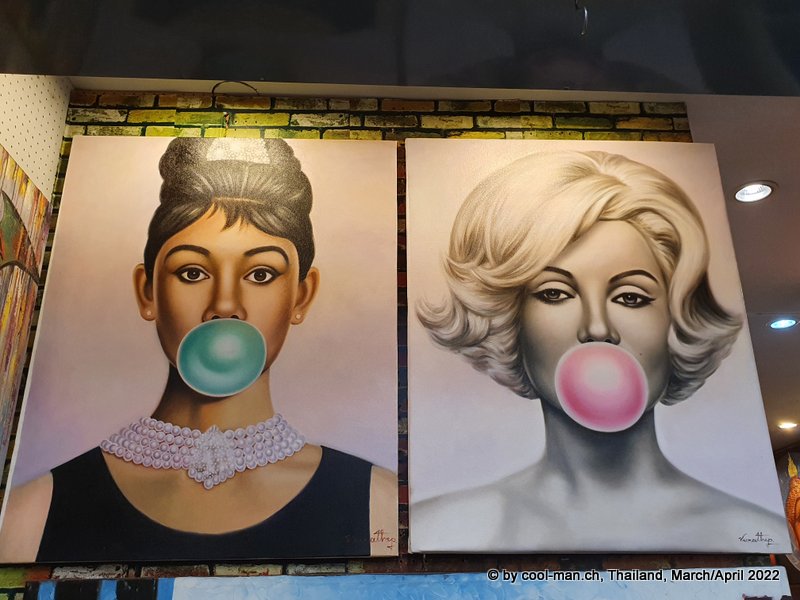
This bar claims that if you pay for a drink, you actually get a drink 😉.

Actually, I wanted to spend a month touring the islands in the southern part of Thailand, but the weather did not cooperate. The sky was overcast every day and it rained often, although the rainy season started only in a few months. The weather forecast was no better.
A colleague of mine was also in Thailand, but a meeting was not planned, because he wanted to tour the north of Thailand. Since the weather forecast was better there, I decided to fly to Chiang Rai in the north with my colleague with no further ado.
Chiang Rai
Here the sun was shining!
We discovered the area with rented scooters.
Wat Khua Khrae Temple
This colorful temple is located 5 km outside of Chiang Rai towards the north.


Mae Fah Luang Art and Culture Park
This park, about 5 km west of Chiang Rai, displays artwork from the former Lanna Kingdom.

Oub Kham Museum
This museum a few kilometers outside Chiang Rai was founded by a member of the royal family of the former Lanna Empire and contains countless artifacts worth seeing.



Bandaam Museum (Black Temple)
The Bandaam Museum, also called Black Temple, is a project of the artist Thawan Duchanee from Chiang Rai. It includes about 40 buildings in different architectural styles, in which the most diverse objects are exhibited such as Buddhas, the skeleton of an elephant, crocodile skins and countless phallic symbols and other erotic objects. One house has the shape of a submarine. Black ice cream colored with ashes was also available, which of course I sampled.
Wat Rong Khun (White Temple)
About 15 km south of Chiang Rai is probably most extraordinary temple in Thailand. It is the life’s work of the Thai artist Chalermchai Kositpipat in honor of Buddha. Unfortunately, our days in Chiang Rai were numbered and we could only visit the temple on a cloudy day. On a sunny day it would have shone much more, because its exterior is covered with shiny glass and mirror plates. The artist has been working on his artwork with male and female students since 1997. New elements are constantly being added. In 2070, the temple should be completed.
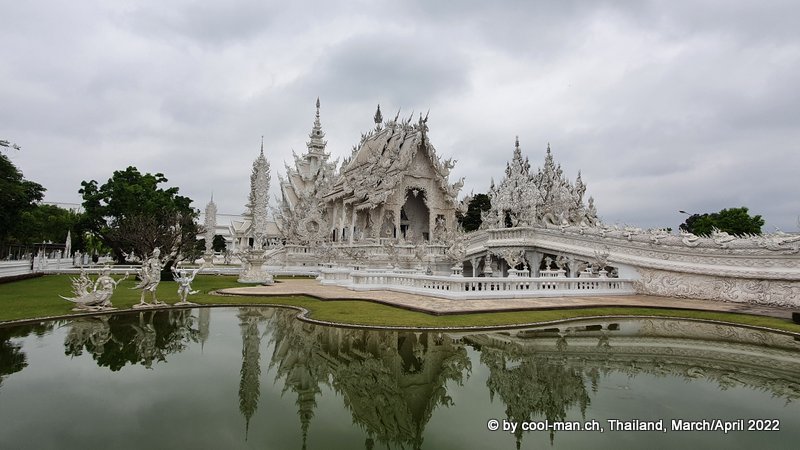
The countless figures surprise with their many details.




Golden Triangle Tour
The next day we started a five-day motorcycle tour north to the border area with Myanmar and Laos.
Chiang Saen
Our first destination was Chiang Saen, a sleepy town on the Mekong River at the border to Laos.

In the evening we experienced a heavy tropical rain shower.

Wat Phrathat Chedi Luang Temple
Started in 1331 and expanded in 1515, the main structure of the temple district was the best preserved. The temple complex was a quiet and idyllic place.

Golden Triangle
The next morning we continued to the Golden Triangle. This is the name of the border area between Thailand, Laos and Myanmar. Since casinos are banned in Thailand, there are casinos in Laos close to the border. The big building in the picture below is the Kings Romans Casino, which is just across the Mekong River.

There is an impressive temple district with many Buddhist statues on the Thai side near the tri-border area.


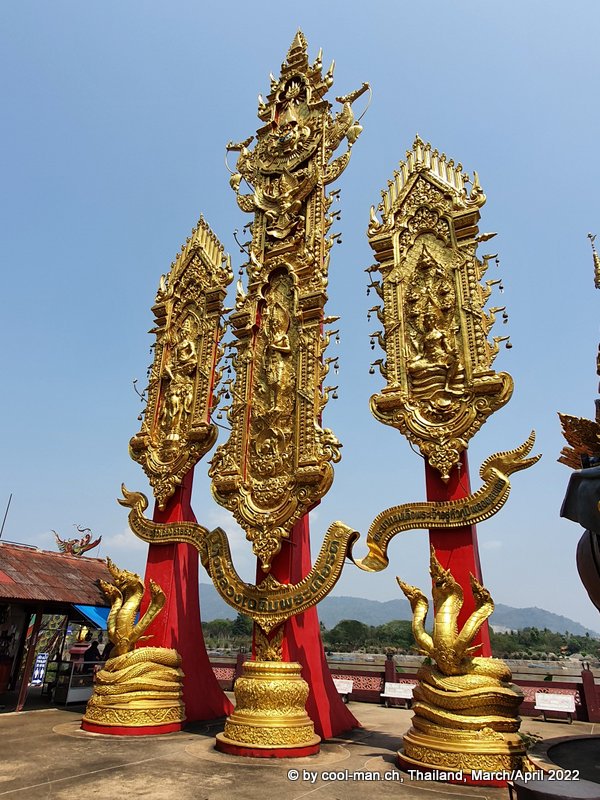

The view from Thailand across the Mekong River to Myanmar (in the middle of the picture) and to Laos (right side of the picture)

Located in the area known for drug production and smuggling is the ‘House of Opium’, an excellent private museum about the history, the plant and tools used such as opium knives, opium scales, pillows and pipes. In addition, an equally interesting exhibition on marijuana and tobacco is located on the second floor.
Mae Sai
We then drove on to the small town of Mae Sai, 25 km away, on the border with Myanmar.
The temple Wat Phra That Doi Wao at dusk

Tham Luang Cave
The next day we headed for the Tham Luang Cave, 20 km away. It became world famous in 2018 when twelve youngsters from a soccer team aged 11 to 16 and their 25-year-old coach were trapped in the cave due to rising water. The rescue involved specialists from more than 10 countries, led by British cave divers. All of the missing people were saved. However, one Thai rescue diver died. As a result, several films and even a Netflix series were produced about the event.
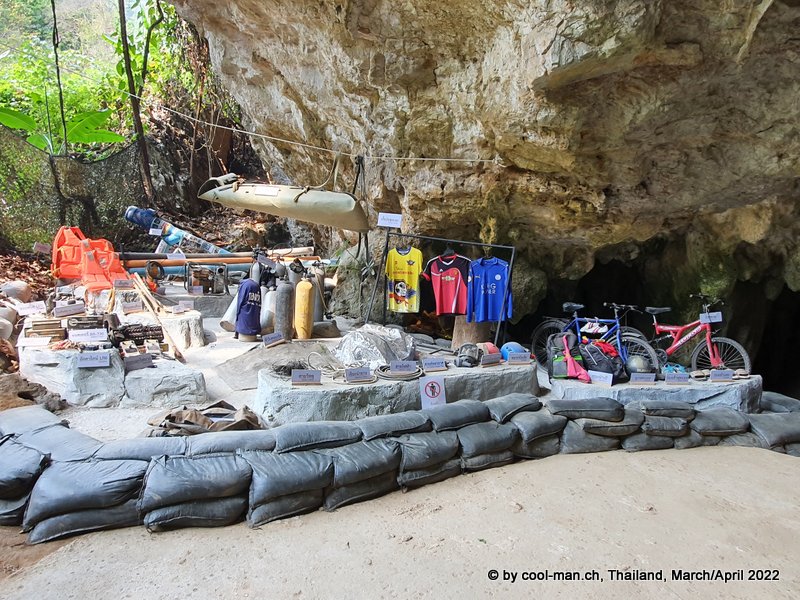

Further on our way along the Myanmar border, we came to this viewing platform overlooking Myanmar.

A statue of a Thai elephant in a forest temple

Phra That Doi Tung Temple
The impressive temple Phra That Doi Tung is also located near the border. The several hundred meters long footpath to the temple is lined with bells.

A wonderful place of tranquility
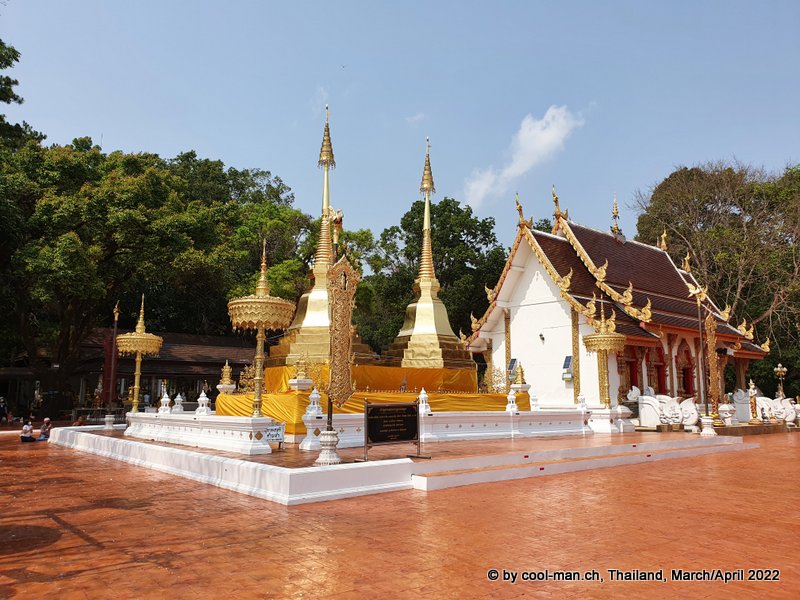

Mae Salong
Mae Salong is a small Thai village near the border with Myanmar. Originally it was a retreat area for the 93rd Division of the Chinese Kuomintang Army, who hid here from the advancing forces of the Chinese Communists after 1949. First living from opium cultivation and processing, people here now grow excellent Oolong tea.
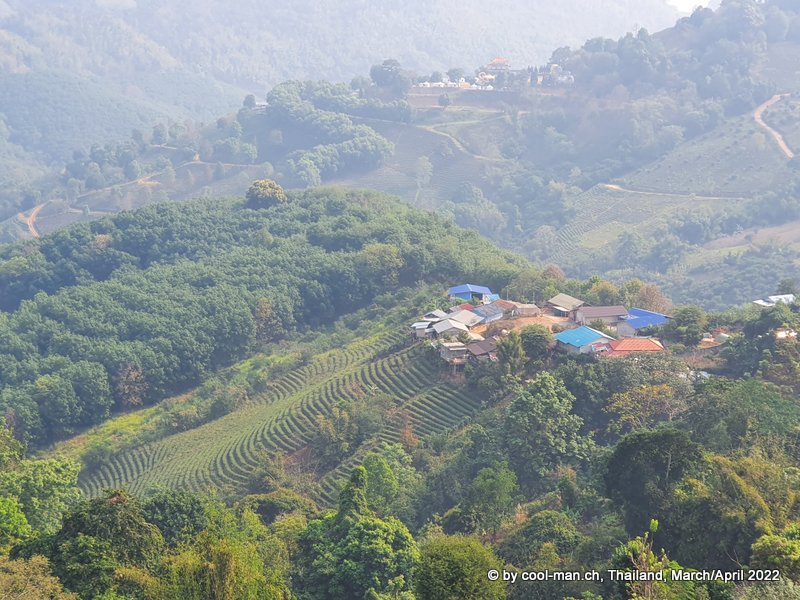
You can taste and buy tea everywhere in the village.

Our breakfast, of course, with Oolong tea!
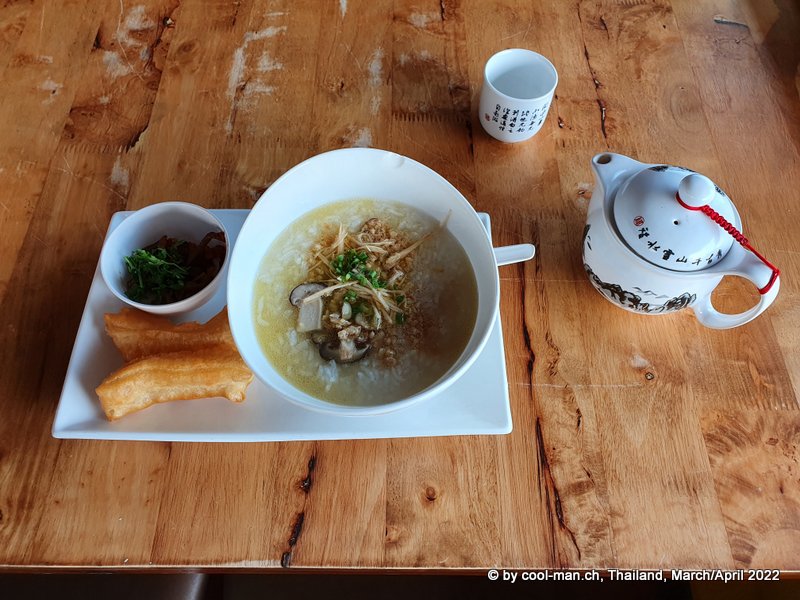
The swimming pool of the Mae Salong Flower Hills Resort
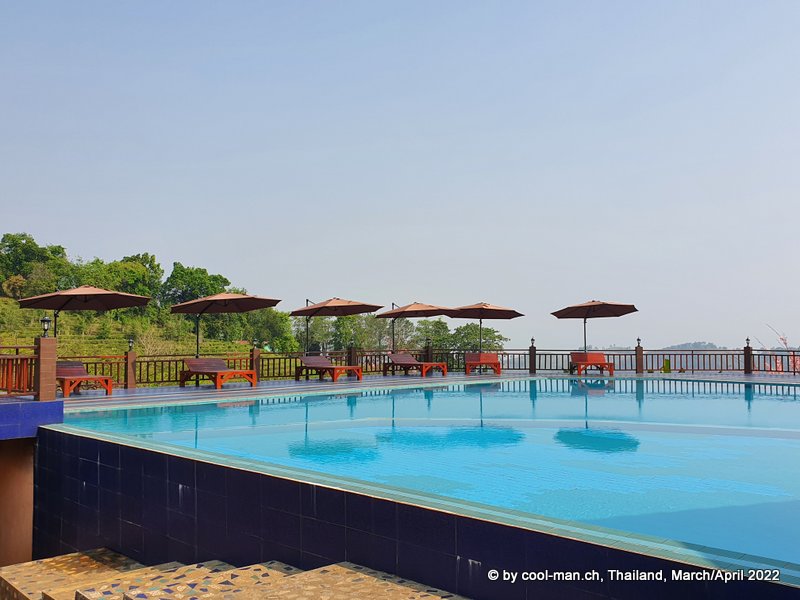
Prabaromathat Chedi Srinakarindra Satismahasantikiri Temple
Prabaromathat Chedi Srinakarindra Satismahasantikiri Temple is located at the top of the highest hill in the area at 1500 meters.
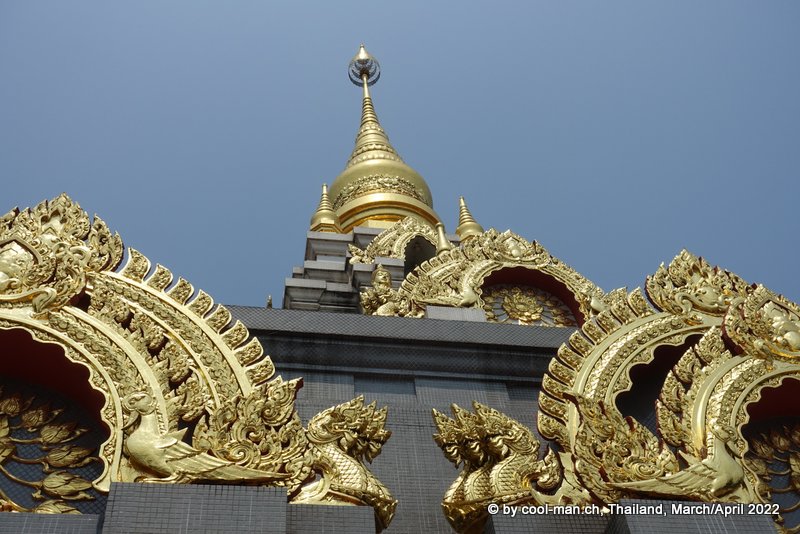

101 Tea Plantation
This tea plantation also offered tastings of excellent tea. I loved the wide view over the tea fields.

After returning from our tour, we took the bus the next day to the largest city in the north of Thailand, Chiang Mai. Since we knew Chiang Mai from previous trips, we immediately got on the next bus to Pai in the mountainous province of Mae Hong Son.
Pai
Despite the pandemic, there were many tourists in Pai, mostly Israeli, as this place is a backpacker’s paradise.
Pai Village Boutique Resort
We stayed more luxuriously in this beautiful resort.



Soon we realized that we were at the wrong time in the north of Thailand, because from February to April the so-called ‘Smoke Season’ is in full swing. This is when the rice fields after harvest and undergrowth in the forests are burned. Thus, the air has a smoky smell and contains many unhealthy micro particles. It also impairs visibility. In addition, some restaurants and attractions were still closed due to the pandemic.
Wat Phra That Mae Yen Temple (White Buddha)
The temple Wat Phra That Mae Yen was just completed, but the paint is already peeling off. Outside the Smoke Season, the view over the valley and Pai is impressive, especially at sunset. Unfortunately, during our visit the view was blurred because of the smoke particles.
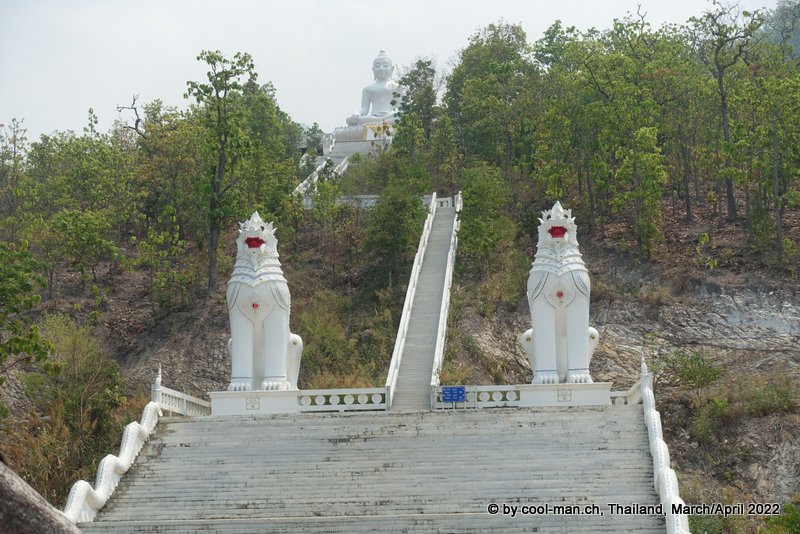
Wat Mai Huay Sai Temple
Another impressive temple

Pai Memorial Bridge
The Pai Memorial Bridge is a rebuilt bridge. The Japanese built the first bridge during the 2nd World War and destroyed it when they withdrawed.

Pai Canyon
This canyon is a sandstone formation up to 75 meters high and several hundred meters long with steeply sloping valleys. The paths on the ridges between the valleys are narrow and sometimes slippery, which adds to the excitement of exploring the canyon.


Kho Kuu So Bamboo Bridge
This bamboo bridge, about one kilometer long, was built for the monks at the nearby Haui Kaai Kiri monastery and forest temple to reach their home dry-footed across the rice fields from the road. Meanwhile, it became a tourist attraction.


The interior of the Haui Kaai Kiri forest temple

Lod Cave
Over 13,000 years old human bones, burial sites and cave paintings several thousand years old have been found in this cave, located about 50 km from Pai. The visit is only possible with a guided tour, which includes an underground raft trip on the Nam River that flows through the cave. The dripstones were impressive. We saw birds living in the cave and thousands of bats, as well as countless fish in the river.



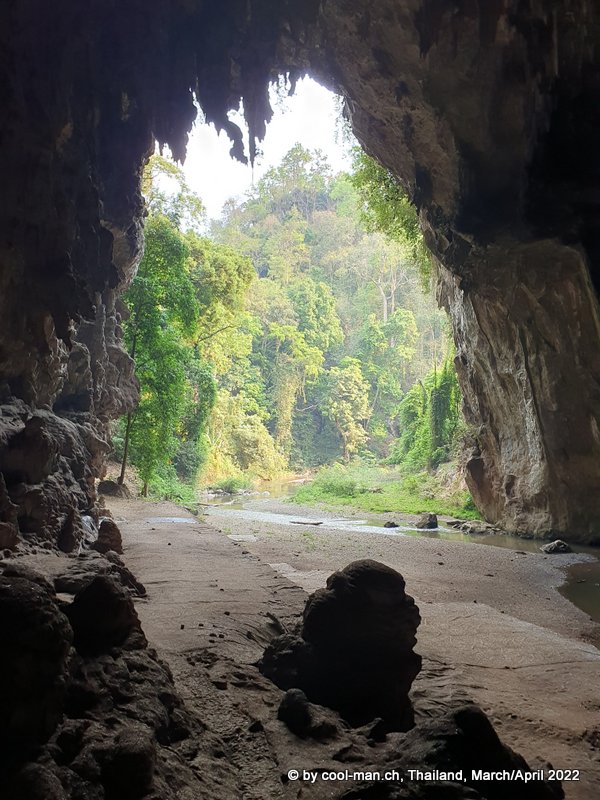
My colleague traveled back to Switzerland and I took the bus to Mae Hong Son, 192 km away, the capital of the province of the same name.
Mae Hong Son
Fern Resort
I stayed at the excellent ‘Fern Resort’, which is supported by the Thai government to provide employment for members of local hill tribes.
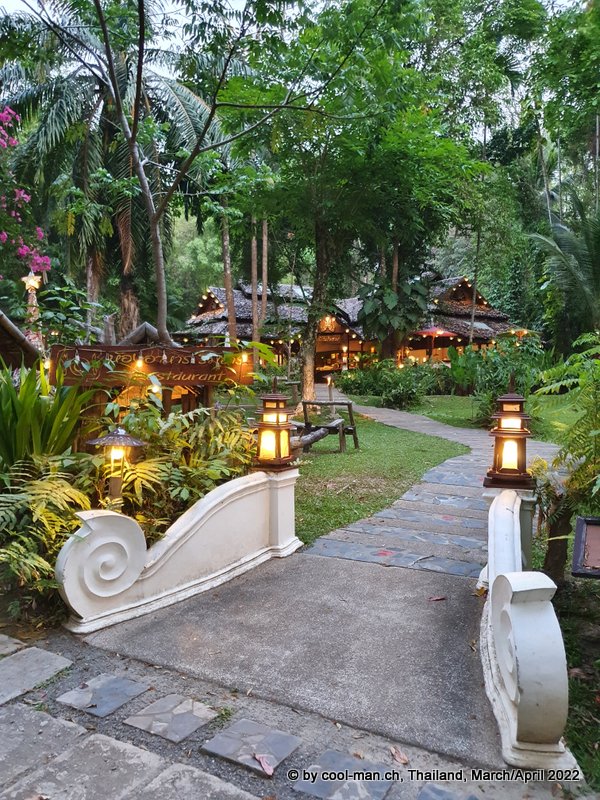


I could choose between two swimming pools. I loved swimming a few laps before breakfast and listening to the chirping birds.


Mae Sakut hiking trail
Right at the resort starts the 8.8 km Mae Sakut hiking trail in the Mae Surin National Park. Despite the air quality app warning that any outdoor exercise was highly hazardous to health, I undertook this hike in the national park.

Throughout my stay in Mae Hong Son province, air pollution was a big problem because of the burning of harvested rice fields and undergrowth in the forests in Mae Hong Son province and in the neighboring country of Myanmar. I considered wearing an FFP2 mask all the time, but as the temperature rose to over thirty degrees Celsius (the above screenshot shows 27 degrees at 8 am), I decided against it. I hope that the reduction of my life expectancy will be limited.
The nature with its plant diversity and the many spiders in the forest were impressive.

Many places in the forest had burned despite the protection of the national park.


The waterfall was a trickle during the prevailing dry season. In addition, there was trash from previous festivities.
In the afternoon, the resort bus took me to the town of Mae Hong Son, 9 km away, where I rented a scooter so that I could explore the area independently.
Mae Hong Son – the provincial capital
The provincial capital is the center of the mountainous province and only 8 km from the border with Myanmar. In the surrounding area live hill tribes such as the Karen, the Shan and the Lisu, some of whom had fled from Myanmar.
Wat Chong Kham Temple
The postcard image of Mae Hong Son with the temple

Wat Phra Non Temple
The next day I visited this temple in the town of Mae Hong Son. It houses an extraordinary 12 meter long reclining Buddha with feminine features.

Behind the temple building is a sitting Buddha.

Wat Phrathat Doi Kongmu Temple
This temple stands on a hill overlooking Mae Hong Son.

The smoke unfortunately impaired the view.

Trip to Huay Pu Keng village

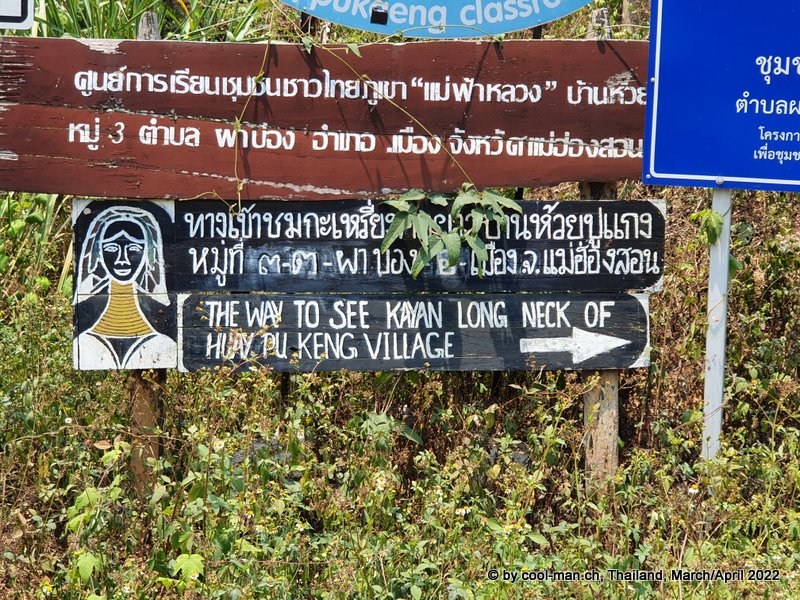
On the way

This man boils tar, which is used for waterproofing the boats.

More burning

The residents of this remote village are refugees from Karenni State of the Kayan and Kayaw people in Myanmar who fled here in the late 1980s, early 1990s. It is the largest Kayan village in Mae Hong Son province. These people live in Thailand, but they do not receive a Thai passport and are not allowed to leave the wider area of their village or engage in regular work. Before they fled, they were farmers, but now they no longer own land. Thus, they live off the tourists who pay an entrance fee to the village and buy handmade souvenirs from them. These villages are visited by tourists mainly because some women wear metal coils (mostly brass) weighing up to 10 kilograms around their necks, which makes their necks appear longer. No one including the villagers themselves know the origin and reason for the neck jewelry. However, the custom is more than a thousand years old.


Beautiful hand woven fabrics


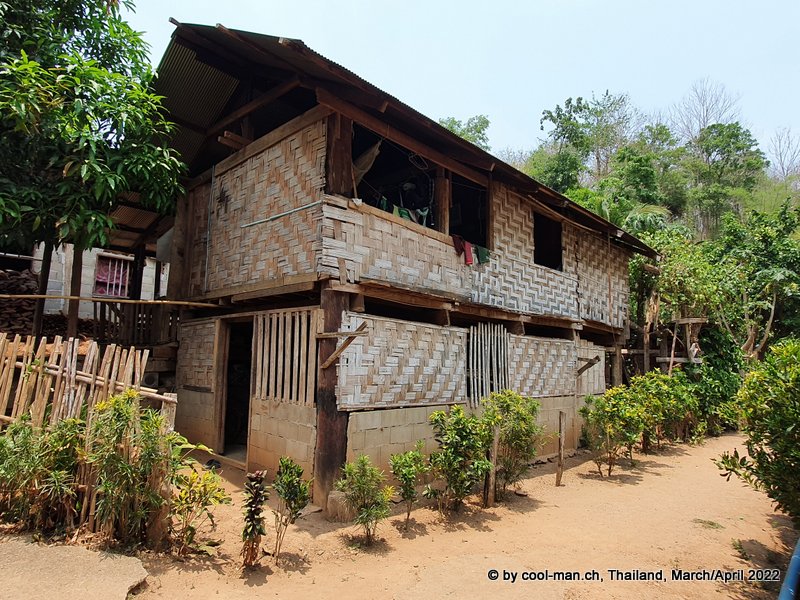
Sacred poles to bring stability to the world.

Missionaries were also active. Thus, there is a Catholic church in the village. Noteworthy is the bell made from a car rim.

Cool hairstyles!

Beautiful shiny hair is important here too!

Trip to Ban Huai Suea Thao village
23 km further, most of it on gravel roads, I visited another village of the Karen people.


My favorite picture

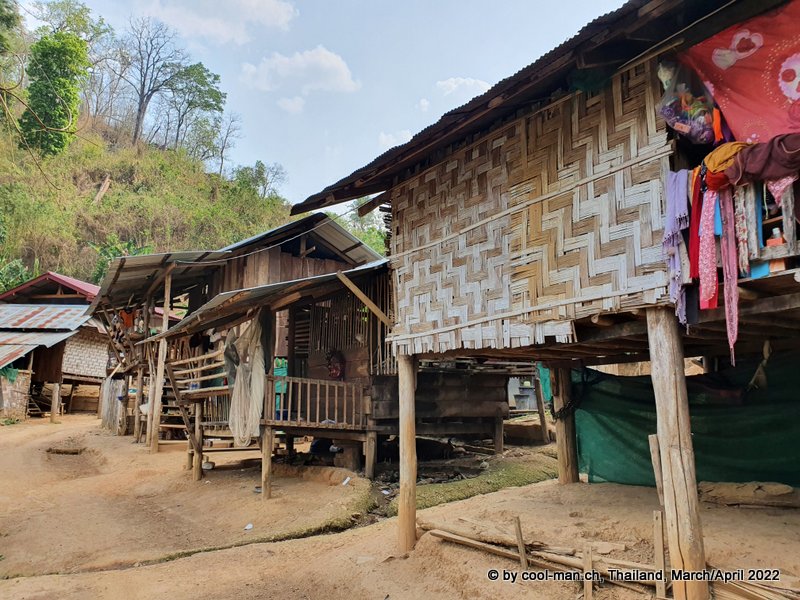


A Buddhist temple just outside the village

Su Tong Pae Bamboo Bridge
The people of Kung May Sak village built this 500 meter long bamboo bridge from their village across the rice fields to Wat Tham Poo Sa Ma temple. It is used every morning by the monks so that they can get to the village and collect the daily alms.

Wat Tham Poo Sa Ma Temple
This is the temple in the background of the picture above. I liked this temple because of the creative sculptures and the view over the valley.


Visitors to the monastery can leave their wishes on wooden boards and who knows, maybe they will come true.




During my visit, I witnessed the delivery of a Buddha statue.


I passed more fires on the way back.

Trip to Ban Mai Nai village
The next day I visited another refugee village, which was even more remote and only accessible by a dirt road.
Typical houses
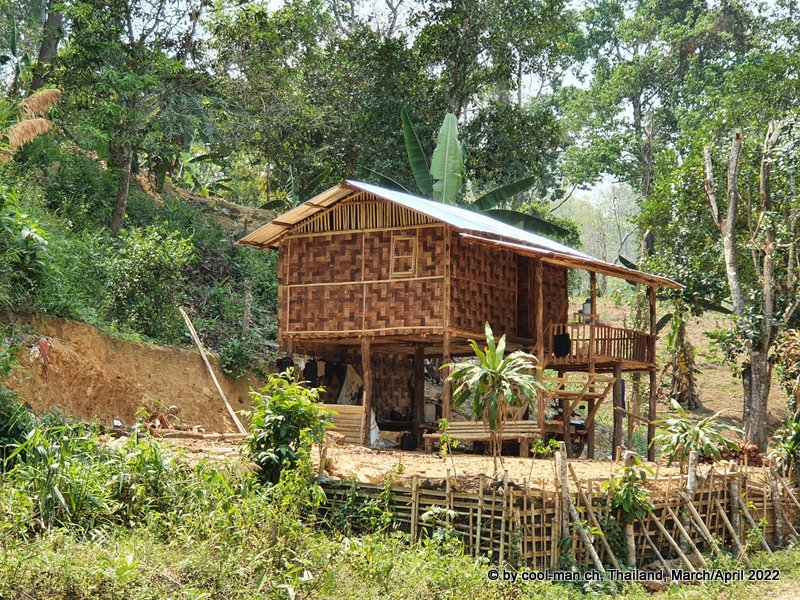

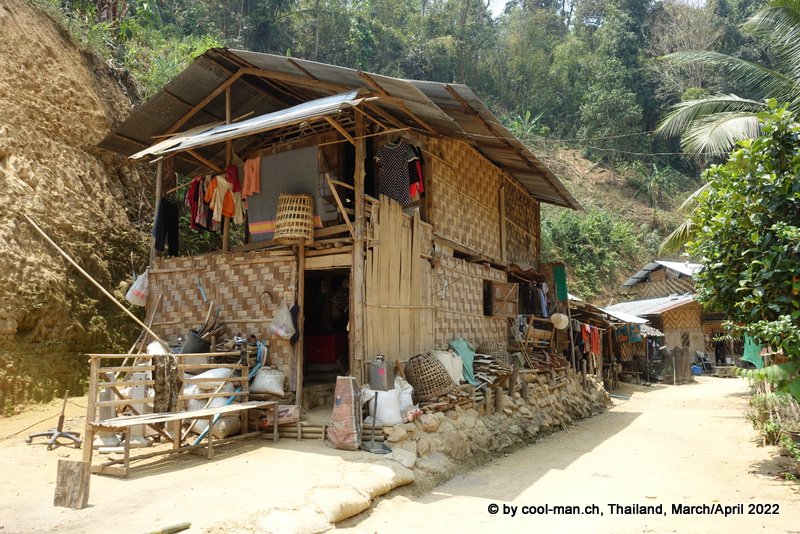

A few hundred meters outside the village there is a spring where the inhabitants fetch their water. There is no running water in the village. This man spoke a little English and told me about his life. His wife is a missionary for the Christian faith. Printing material, the motorcycle and gasoline cost money, which is scarce here. Any help is welcome. You can contact me if you want to support the missionary work.

The son of the family learning English.

Old women with the traditional necklace also live here.

Trip to Ban Rak Thai village
On my last day in Mae Hong Son Province, I rode my scooter 43 km north to Ban Rak Thai village, less than a kilometer away from the border with Myanmar. Like Mae Salong, this area was a retreat of the National Chinese Kuomintang Army. The Chinese influence is unmistakable. There are Chinese signposts, the houses are built in Chinese style and many people speak Mandarin Chinese. As in Mae Salong, the area has specialized in tea growing thanks to the cooler mountain climate.
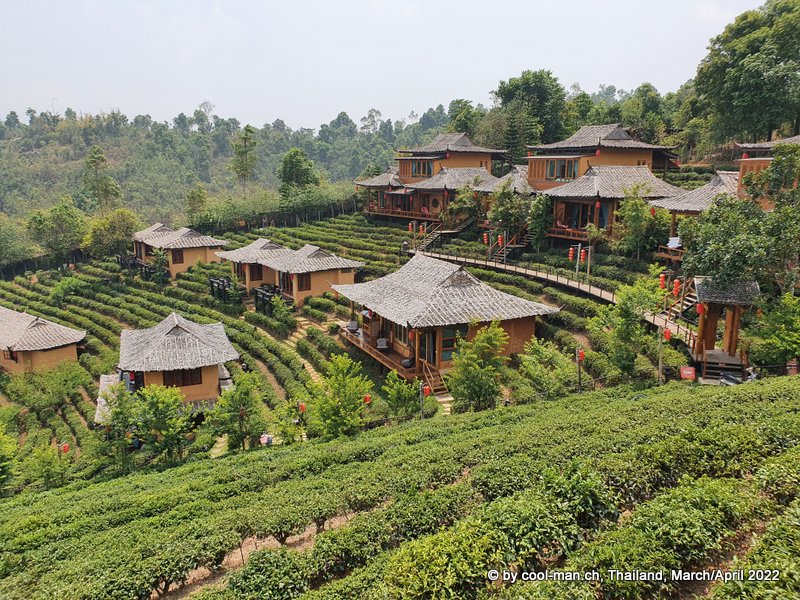
The village is built around a lake.

Green tea and green tea cake – a perfect day!

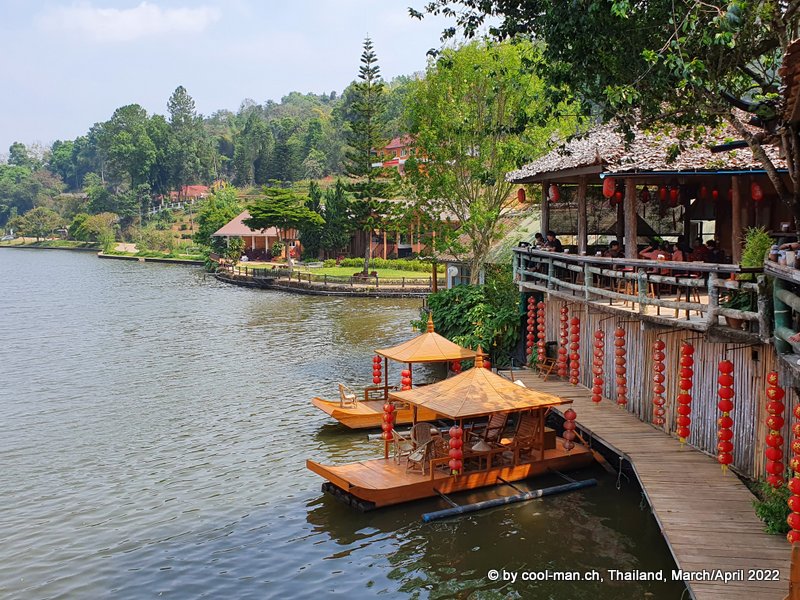
After a long drive back to Mae Hong Son and two flights the next day, I landed in Phuket, from where I traveled on to Mauritius.
This text is an automatic English translation from the German original by deepl.com